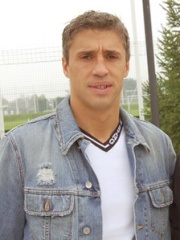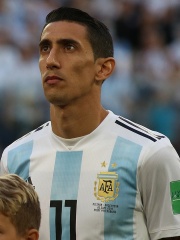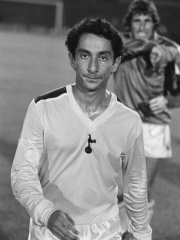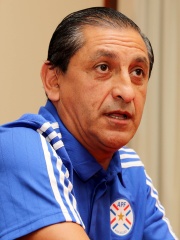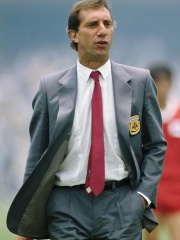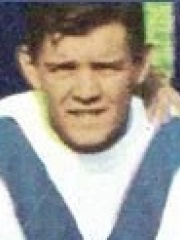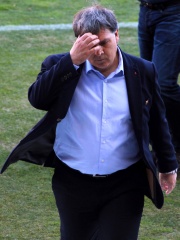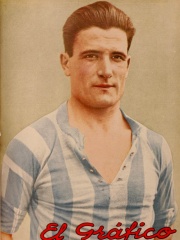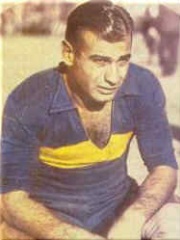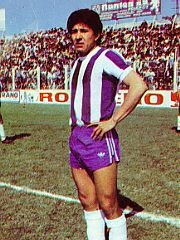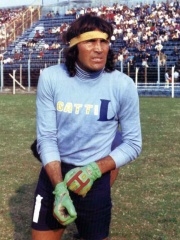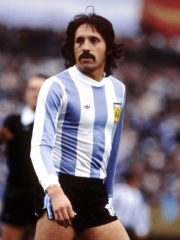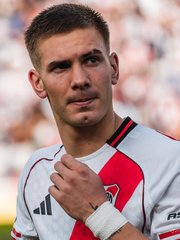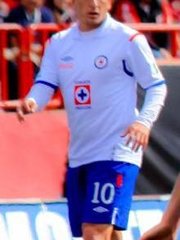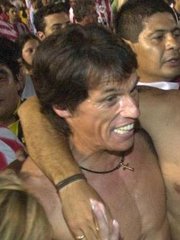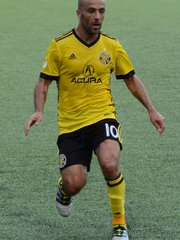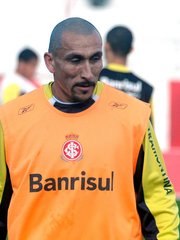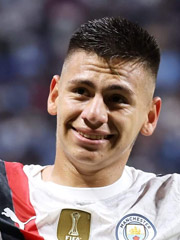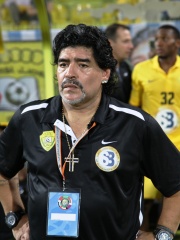
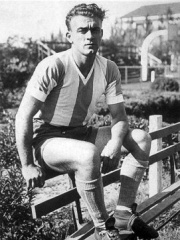
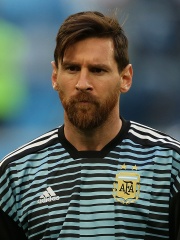

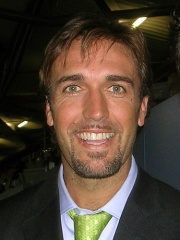
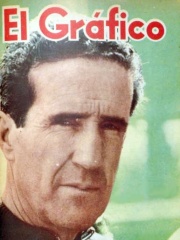
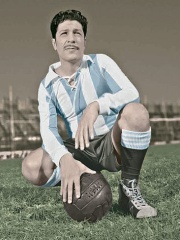
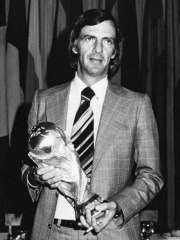
The Most Famous
SOCCER PLAYERS from Argentina
This page contains a list of the greatest Argentinean Soccer Players. The pantheon dataset contains 21,273 Soccer Players, 736 of which were born in Argentina. This makes Argentina the birth place of the 8th most number of Soccer Players behind Germany, and Italy.
Top 10
The following people are considered by Pantheon to be the top 10 most legendary Argentinean Soccer Players of all time. This list of famous Argentinean Soccer Players is sorted by HPI (Historical Popularity Index), a metric that aggregates information on a biography's online popularity. Visit the rankings page to view the entire list of Argentinean Soccer Players.

1. Diego Maradona (1960 - 2020)
With an HPI of 82.55, Diego Maradona is the most famous Argentinean Soccer Player. His biography has been translated into 142 different languages on wikipedia.
Diego Armando Maradona (30 October 1960 – 25 November 2020) was an Argentine professional football player and manager. Widely regarded as one of the greatest players in the history of the sport, he was one of the two joint winners of the FIFA Player of the 20th Century award, alongside Pelé. An advanced playmaker who operated in the classic number 10 position, Maradona's vision, passing, ball control, and dribbling skills were combined with his small stature, which gave him a low centre of gravity and allowed him to manoeuvre better than most other players. His presence and leadership on the field had a great effect on his team's general performance, while he would often be singled out by the opposition. In addition to his creative abilities, he possessed an eye for goal and was known to be a free kick specialist. A precocious talent, Maradona was given the nickname El Pibe de Oro ("The Golden Boy"), a name that stuck with him throughout his career. Maradona was the first player to set the world record transfer fee twice: in 1982 when he transferred to Barcelona for £5 million, and in 1984 when he moved to Napoli for a fee of £6.9 million. He played for Argentinos Juniors, Boca Juniors, Barcelona, Napoli, Sevilla and Newell's Old Boys during his club career, and is most famous for his time at Napoli where he won numerous accolades and led the club to their first Serie A title win only to do it all over again three years later. Maradona also had a troubled off-field life and his time with Napoli ended after he was banned for taking cocaine. In his international career with Argentina, he earned 91 caps and scored 34 goals. Maradona played in four FIFA World Cups, including the 1986 World Cup in Mexico, where he captained Argentina and led them to victory over West Germany in the final, and won the Golden Ball as the tournament's best player. In the 1986 World Cup quarter final, he scored both goals in a 2–1 victory over England that entered football history for two different reasons. The first goal was an unpenalized handling foul known as the "Hand of God", while the second goal followed a 60 m (66 yd) dribble past five England players, voted "Goal of the Century" by FIFA.com voters in 2002. Maradona also had a career in management. He became the coach of Argentina's national football team in November 2008. He was in charge of the team at the 2010 World Cup in South Africa before leaving at the end of the tournament. He then coached Dubai-based club Al Wasl in the UAE Pro-League for the 2011–12 season. In 2017, Maradona became the coach of Fujairah before leaving at the end of the season. From May to September 2018, he was the chairman of Dynamo Brest. From September 2018 to June 2019, Maradona was coach of Mexican club Dorados, and was the coach of Argentine Primera División club Gimnasia de La Plata from September 2019 until his death in 2020. In 2022, he was ranked as the third best football player of all time by football magazine FourFourTwo. In August 2024, the International Sports Press Association (AIPS) voted him as the second best footballer of the past 100 years after Pelé.

2. Alfredo Di Stéfano (1926 - 2014)
With an HPI of 81.89, Alfredo Di Stéfano is the 2nd most famous Argentinean Soccer Player. His biography has been translated into 78 different languages.
Alfredo Stéfano Di Stéfano Laulhé (Spanish pronunciation: [alˈfɾeðo ðjesˈtefano]; 4 July 1926 – 7 July 2014) was an Argentine and naturalised Spanish professional footballer and manager who played as a forward, widely regarded as one of the greatest players of all time and as one of the greatest Real Madrid players ever. Nicknamed "Saeta Rubia" ("Blond Arrow"), he is best known for his achievements with Real Madrid, where he was instrumental in the club's domination of the European Cup and La Liga during the 1950s and 1960s. Along with Francisco Gento and José María Zárraga, he was one of only three players to play a part in all five European Cup victories, scoring goals in each of the five finals. Di Stéfano played international football mostly for Spain after moving to Madrid and becoming a naturalised citizen, but he also played for Argentina. Di Stéfano began his career at Argentina's River Plate aged 17, in 1943. For the 1946 season, he was loaned to Huracán, but he returned to River in 1947. He won Copa America in 1947 with Argentina. Due to a footballers' strike in Argentina in 1949, Di Stéfano went to play for Millonarios of Bogotá in the Colombian league. He won six league titles during the first 12 years of his career in Argentina and Colombia. Following his signing by Real Madrid, he was an integral part of one of the most successful teams of all time. He scored 216 league goals in 282 games for Real (then a club record, since surpassed by Raúl, Cristiano Ronaldo and Karim Benzema), striking up a successful partnership with Ferenc Puskás. Di Stéfano's 49 goals in 58 matches was the all-time highest tally in the European Cup. The record has since been surpassed by several players, including the aforementioned Real Madrid trio. Di Stéfano scored in five consecutive European Cup finals for Real Madrid between 1956 and 1960, including a hat-trick in the last. Perhaps the highlight of his time with the club was their 7–3 victory over Eintracht Frankfurt in the 1960 final at Hampden Park, a game many consider to be the finest exhibition of club football ever witnessed in Europe. He moved to Espanyol in 1964 and played there until retiring at the age of 40. Di Stéfano was awarded the Ballon d'Or for the European Footballer of the Year in 1957 and 1959. He is currently the seventh highest scorer in the history of Spain's top division, and Real Madrid's fourth highest league goalscorer of all time. He is Madrid's leading goalscorer in the history of El Clásico, alongside Cristiano Ronaldo. In November 2003, to celebrate UEFA's Jubilee, he was selected as the Golden Player of Spain by the Royal Spanish Football Federation as their most outstanding player of the past 50 years. He was voted fourth, behind Pelé, Diego Maradona, and Johan Cruyff, in a vote organized by France Football magazine which consulted their former Ballon d'Or winners to elect the Football Player of the Century. In 2004, he was named by Pelé in the FIFA 100 list of the world's greatest living players (in September 2009, he said Di Stéfano was the best player "ever"). In 2008 Di Stéfano was honoured by both UEFA and Real Madrid with a special Presidents' award issued by FIFA at a ceremony in Madrid, where a statue was also unveiled. Then UEFA President Michel Platini called Di Stéfano "a great amongst the greats" while contemporaries Eusébio and Just Fontaine suggested that he was "the most complete footballer in the history of the game".

3. Lionel Messi (b. 1987)
With an HPI of 75.26, Lionel Messi is the 3rd most famous Argentinean Soccer Player. His biography has been translated into 185 different languages.
Lionel Andrés "Leo" Messi (born 24 June 1987) is an Argentine professional footballer who plays as a forward for and captains both Major League Soccer club Inter Miami and the Argentina national team. Widely regarded as one of the greatest players in history, Messi has set numerous records for individual accolades won throughout his professional footballing career, including eight Ballon d'Ors, six European Golden Shoes, and eight times being named the world's best player by FIFA. In 2025, he was named the All Time Men's World Best Player by the IFFHS. He is the most decorated player in the history of professional football having won 46 team trophies. Messi's records include most goals in a calendar year (91), most goals for a single club (672 for Barcelona), most goals in La Liga (474), most assists in international football (61), most goal contributions in the FIFA World Cup (21), and most goal contributions in the Copa América (32). A prolific goalscorer and creative playmaker, Messi has scored over 890 senior career goals and provided over 400 assists for club and country—the most of any player—resulting in over 1,300 goal contributions, the highest total in the sport's history. Messi made his competitive debut for Barcelona at age 17 in October 2004. He gradually established himself as an integral player for the club, and during his first uninterrupted season at age 22 in 2008–09 he helped Barcelona achieve the first treble in Spanish football. This resulted in Messi winning the first of four consecutive Ballon d'Ors, and by the 2011–12 season he set the European record for most goals in a season and established himself as Barcelona's all-time top scorer. During the 2014–15 campaign, where he became the all-time top scorer in La Liga, he led Barcelona to a historic second treble, leading to a fifth Ballon d'Or in 2015. He assumed Barcelona's captaincy in 2018 and won a record sixth Ballon d'Or in 2019. At Barcelona, Messi won a club-record 34 trophies, including ten La Liga titles and four Champions Leagues, among others. Financial difficulties at Barcelona led to Messi signing with French club Paris Saint-Germain in August 2021, where he won the Ligue 1 title during both of his seasons there. He joined MLS club Inter Miami in July 2023, leading the club to win their first MLS Cup in 2025, whilst also winning back-to-back league MVP awards in 2024 and 2025. An Argentine international, Messi is the national team's all-time leading goalscorer and most-capped player. Several years after his senior debut in 2005, he won the gold medal at the 2008 Summer Olympics. Assuming captaincy in 2011, he led Argentina to three consecutive finals in the 2014 World Cup, the 2015 Copa América and the Copa América Centenario, all of which they lost. After initially announcing his international retirement in 2016, he returned to help his country narrowly qualify for the 2018 World Cup. Messi was central to ending Argentina's 28-year trophy drought by winning the 2021 Copa América, which helped him secure his seventh Ballon d'Or that year. In the following year, he led Argentina to winning the 2022 World Cup, the country's first in 36 years. This followed with a record-extending eighth Ballon d'Or in 2023. Messi was victorious at the 2024 Copa América, his third major international title. Messi has endorsed sportswear company Adidas since 2006. According to France Football, he was the world's highest-paid footballer for five years out of six between 2009 and 2014, and was ranked the world's highest-paid athlete by Forbes in 2019 and 2022. Messi was among Time's 100 most influential people in the world in 2011, 2012, and 2023. In 2020 and 2023, he was named the Laureus World Sportsman of the Year, the first team-sport athlete to win it. In 2020, Messi was named to the Ballon d'Or Dream Team and became the second footballer and second team-sport athlete to surpass $1 billion in career earnings. Following his arrival and impact on football in the US, Messi was named Time's Athlete of the Year in 2023, and was bestowed with the Presidential Medal of Freedom by US president Joe Biden in 2025.

4. Omar Sívori (1935 - 2005)
With an HPI of 73.09, Omar Sívori is the 4th most famous Argentinean Soccer Player. His biography has been translated into 51 different languages.
Enrique Omar Sívori (Spanish: [enˈrike oˈmaɾ ˈsiβoɾi], Italian: [ˈɔːmar ˈsiːvori]; 2 October 1935 – 17 February 2005) was an Argentine-Italian football player and manager who played as a forward. At club level, he is known for his successful time with Italian side Juventus during the late 1950s and early 1960s, where he won three Serie A titles among other trophies; he also played for River Plate in Argentina and Napoli in Italy. He made his international debut for Argentina, winning the South American Championship in 1957. Later in his career, he represented Italy and took part in the 1962 World Cup. After his retirement as player, he coached several teams in Argentina. Sívori is considered as one of the best players of his generation and also one of the greatest players of all time, he was known for his skill, speed, goalscoring, technique, creativity, and his footballing talent was widely acclaimed. He won the South American Championship Best Player award in 1957, and the coveted Ballon D'Or award in 1961. He scored 432 goals in his career, including friendlies.
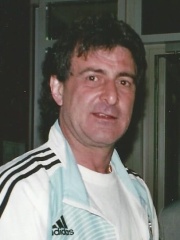
5. Mario Kempes (b. 1954)
With an HPI of 72.38, Mario Kempes is the 5th most famous Argentinean Soccer Player. His biography has been translated into 64 different languages.
Mario Alberto Kempes Chiodi (Spanish pronunciation: [ˈmaɾjo alˈβeɾto ˈkempes ˈtʃjoði], Italian: [ˈkjɔːdi]; born 15 July 1954) is an Argentine former professional footballer who played as a striker or attacking midfielder. A prolific goalscorer, he finished as La Liga's top goalscorer twice with Valencia where he amassed 116 goals in 184 league games. He is regarded as one of the greatest players of all time. At international level, Kempes was the focal point of Argentina's 1978 World Cup win where he scored twice in the final and received the Golden Boot as top goalscorer. He also won the Golden Ball for the player of the tournament, making him one of only three players to have won all three awards at a single World Cup, along with Garrincha in 1962 and Paolo Rossi in 1982. Kempes won South American Footballer of the Year, Onze d'Or European footballer of the Year and World Cup Golden Ball in 1978. In 2004, he was named as one of the Top 125 greatest living footballers as part of FIFA's 100th anniversary celebration. Kempes was nicknamed El Toro and El Matador.

6. Gabriel Batistuta (b. 1969)
With an HPI of 71.45, Gabriel Batistuta is the 6th most famous Argentinean Soccer Player. His biography has been translated into 65 different languages.
Gabriel Omar Batistuta (Spanish pronunciation: [ɡaˈβɾjel oˈmaɾ βatisˈtuta]; born 1 February 1969) is an Argentine former professional footballer. During his playing career, Batistuta was nicknamed Batigol ([batiˈɣol]) as well as El Ángel Gabriel ([el ˌaŋxel ɣaˈβɾjel]; Spanish for Angel Gabriel). Regarded as one of the best strikers of all time, he was named by Pelé in the FIFA 100 list of the world's greatest living players in 2004. After beginning his career in Argentina in 1988 with Newell's Old Boys, followed by River Plate and Boca Juniors where he won titles, Batistuta played most of his club football with Serie A club Fiorentina in Italy; he is their all-time top scorer in Serie A with 151 goals. When Fiorentina was relegated to Serie B in 1993, Batistuta stayed with the club and helped them return to the top-flight league a year later. He became an icon in Florence; the Fiorentina fans erected a life-size bronze statue of him in 1996, in recognition of his performances for the club. Despite winning the Coppa Italia and the Supercoppa Italiana with the club in 1996, he never won the Serie A title with Fiorentina, but when he moved to Roma in 2000 for €36 million – the highest fee ever paid for a player over the age of 30 until Cristiano Ronaldo moved from Real Madrid to Juventus in 2018 – he won the 2000–01 Serie A title. After a brief loan spell with Inter Milan in 2003, he played his last two seasons in Qatar with Al-Arabi before he retired in 2005. At international level, Batistuta was Argentina's all-time leading goalscorer with 56 goals in 78 official matches, a record he held until 21 June 2016, when he was surpassed by Lionel Messi. He participated in three FIFA World Cups, scoring 10 goals, making him Argentina's second top scorer in the competition after Messi, and the joint tenth-highest World Cup goalscorer of all time. Batistuta is the only player in football history to score two hat-tricks in different World Cups. With the Argentina national team he won two consecutive Copa América titles (1991 and 1993), the 1993 CONMEBOL–UEFA Cup of Champions, and the 1992 FIFA Confederations Cup.

7. Helenio Herrera (1910 - 1997)
With an HPI of 71.16, Helenio Herrera is the 7th most famous Argentinean Soccer Player. His biography has been translated into 36 different languages.
Helenio Herrera Gavilán (Spanish pronunciation: [eˈlenjo eˈreɾa ɣaβiˈlan]; 10 April 1910 – 9 November 1997) was an Argentine and naturalised French football player and manager. He is best remembered for his success with the Inter Milan team known as Grande Inter in the 1960s. During his managerial career, Herrera won four La Liga titles in Spain (with Atlético Madrid and Barcelona) and three Serie A titles in Italy with Inter. He also guided Inter to European glory, winning two consecutive European Cups, among several other honours. He is regarded as one of the greatest managers of all time. Herrera was arguably the first manager to collect credit for his teams' performances, in the process becoming a superstar in the world of football. Up to that time, managers were more marginal figures in a team. All teams throughout Europe were known for their headline-grabbing individual players, e.g. Di Stéfano's Real Madrid, whereas Inter during the 1960s is still referred to as Herrera's Inter.

8. Guillermo Stábile (1905 - 1966)
With an HPI of 71.12, Guillermo Stábile is the 8th most famous Argentinean Soccer Player. His biography has been translated into 45 different languages.
Guillermo Stábile (17 January 1905 – 26 December 1966) was an Argentine professional football player and manager who played as a centre forward. At club level, Stábile won two national championships with Huracán and played in Italy and France. He was the top scorer of the 1930 FIFA World Cup, the inaugural iteration of the tournament. As manager, he led Argentina to victory at six South American Championships and Racing Club to three league titles.

9. César Luis Menotti (1938 - 2024)
With an HPI of 70.04, César Luis Menotti is the 9th most famous Argentinean Soccer Player. His biography has been translated into 46 different languages.
César Luis Menotti (Spanish pronunciation: [ˈsesaɾ ˈlwis meˈnoti]; 22 October 1938 – 5 May 2024), known as El Flaco ("Slim"), was an Argentine football player and manager who won the 1978 FIFA World Cup as the head coach of the Argentina national team. Menotti played as a striker, most notably for Argentine clubs Rosario Central and Boca Juniors. As a manager, he won three cups with Barcelona and also led Atlético Madrid in La Liga in the 1980s, as well as leading Superclásico rivals Boca Juniors and River Plate. He was briefly the manager of Mexico and Italian Serie A club Sampdoria in the 1990s. During Menotti's tenure as manager of the Argentina national team (from 1974 to 1982), he carried out a project that differed from previous processes, bringing him to be recognised as one of the most influential managers in the history of Argentine football.

10. Daniel Passarella (b. 1953)
With an HPI of 69.86, Daniel Passarella is the 10th most famous Argentinean Soccer Player. His biography has been translated into 53 different languages.
Daniel Alberto Passarella (born 25 May 1953) is an Argentine former footballer and manager, who is considered one of the greatest defenders of all time. As a player for Argentina, he was part of two FIFA World Cup-winning teams; he captained his nation to victory at the 1978 World Cup which Argentina hosted, and was also part of the winning squad in 1986.He was the only Argentine player to win two world cups. Although playing as a centre-back, Passarella was also a proficient goalscorer; at one point, he was football's highest-scoring defender, with 134 goals in 451 matches, a record which was subsequently broken by Dutch player Ronald Koeman. In 2004, Passarella was named one of the 125 greatest living footballers by Pelé at a FIFA awards ceremony. In 2007, The Times placed him at 36th in their list of the 50 hardest footballers in history, recalling that he "tackled with the ferocity of the wild bull of the Pampas". In 2017, he was named as the 56th best player by FourFourTwo in their list of the 100 all-time greatest footballers. As a manager, he coached the Argentina and Uruguay national teams, among several club sides. After his playing and coaching career, Passarella also served as the president of River Plate for four years, after winning the elections in December 2009.
People
Pantheon has 736 people classified as Argentinean soccer players born between 1885 and 2007. Of these 736, 596 (80.98%) of them are still alive today. The most famous living Argentinean soccer players include Lionel Messi, Mario Kempes, and Gabriel Batistuta. The most famous deceased Argentinean soccer players include Diego Maradona, Alfredo Di Stéfano, and Omar Sívori. As of April 2024, 75 new Argentinean soccer players have been added to Pantheon including Franco Mastantuono, Andrés Guglielminpietro, and Christian Giménez.
Living Argentinean Soccer Players
Go to all RankingsLionel Messi
1987 - Present
HPI: 75.26
Mario Kempes
1954 - Present
HPI: 72.38
Gabriel Batistuta
1969 - Present
HPI: 71.45
Daniel Passarella
1953 - Present
HPI: 69.86
Hernán Crespo
1975 - Present
HPI: 69.25
Javier Zanetti
1973 - Present
HPI: 68.47
Ángel Di María
1988 - Present
HPI: 67.10
Osvaldo Ardiles
1952 - Present
HPI: 66.71
Ramón Díaz
1959 - Present
HPI: 66.64
Carlos Bilardo
1938 - Present
HPI: 66.29
Jorge Solari
1941 - Present
HPI: 66.03
Gerardo Martino
1962 - Present
HPI: 65.98
Deceased Argentinean Soccer Players
Go to all RankingsDiego Maradona
1960 - 2020
HPI: 82.55
Alfredo Di Stéfano
1926 - 2014
HPI: 81.89
Omar Sívori
1935 - 2005
HPI: 73.09
Helenio Herrera
1910 - 1997
HPI: 71.16
Guillermo Stábile
1905 - 1966
HPI: 71.12
César Luis Menotti
1938 - 2024
HPI: 70.04
Luis Monti
1901 - 1983
HPI: 68.86
Francisco Varallo
1910 - 2010
HPI: 67.94
Luis Galván
1948 - 2025
HPI: 67.75
Hugo Gatti
1944 - 2025
HPI: 67.37
Raimundo Orsi
1901 - 1986
HPI: 67.37
Leopoldo Luque
1949 - 2021
HPI: 64.80
Newly Added Argentinean Soccer Players (2025)
Go to all RankingsFranco Mastantuono
2007 - Present
HPI: 49.24
Andrés Guglielminpietro
1974 - Present
HPI: 47.34
Christian Giménez
1981 - Present
HPI: 47.20
José Luis Calderón
1970 - Present
HPI: 45.54
Diego Latorre
1969 - Present
HPI: 45.34
Darío Rojas
1961 - Present
HPI: 45.14
Federico Higuaín
1984 - Present
HPI: 45.11
Ricardo Altamirano
1965 - Present
HPI: 44.93
Sebastián Rambert
1974 - Present
HPI: 44.60
Juan José Borrelli
1970 - Present
HPI: 44.31
Pablo Guiñazú
1978 - Present
HPI: 44.22
Claudio Echeverri
2006 - Present
HPI: 44.17
Overlapping Lives
Which Soccer Players were alive at the same time? This visualization shows the lifespans of the 25 most globally memorable Soccer Players since 1700.

